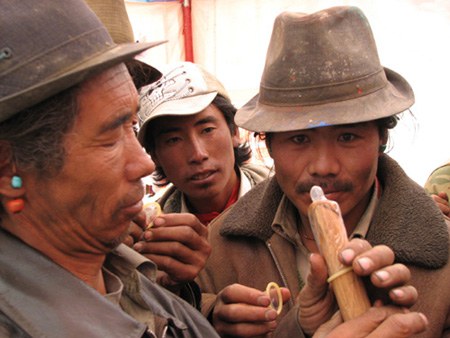
Join in circuit on AIDS, love and sexuality
The news about HIV is still not spread to all corners of the globe. However, once the information reaches, the impact is immense. The evaluation of the ‘Join in circuit’ carried out with the rural population in Shigatse Prefecture of the Tibet Autonomous Region has shown impressive results in terms of knowledge increase.
Along term impact on behavior change will, among other factors, depend on the broadening of scope to merge family planning and disease control in order to bring sexual reproductive health and dual protection forward within the Chinese health policy.
The situation of Sexual Reproductive Health and HIV/AIDS in Tibet
Risk factors in the Tibet Autonomous Region (TAR) are many fold: a large migrant population within TAR and from ‘mainland’ China induces prostitution. Polyandry is still practiced in more than one third of the families. Sex outside marriage is generally tolerated well in Tibetan society. Knowledge about HIV is very low and condoms not well known. Even though family planning is compulsory in China, the condom is not well promoted for family planning, let alone for protection of HIV. Sexually Transmitted Infections (STIs) are wide spread. Underreporting of STIs appears to be high since health workers at grass root level are not trained to sufficiently detect them.
Official data on HIV prevalence in TAR are not published. However, the HIV prevalence is estimated to be on a sharp increase. While 70 cases were reported by the local Center for Disease Control (CDC) during 1993-2008, the figure increased by 130 new cases in 2009-2010. In recent years the response to HIV has been much scaled up. The CDC carries out Voluntary Counseling and Testing (VCT) at Prefecture level with some person groups being compelled to go for VCT. Since 2010 anti-retroviral treatment is also supplied there. Rapid tests are done in the county. All persons living with HIV and AIDS are registered in a central database. Once their status is confirmed they are sent back to their place of home. Even though officially the names and data of the positive persons are not disclosed, their exclusion from the workplace and forced return to their homeland indicates the high level of stigmatization and discrimination in the country.
HIV Prevention and Join in circuit by the SRC
The SRC is the first NGO in TAR which implements an integrated approach of SRH and HIV/AIDS in all the HIV prevention activities. HIV prevention is tailored to the needs and scope of the different target groups. During peer education for vocational school students, information stands for the general public, the HIV Join in circuit or workshops and counseling for individual bar girls, the SRC team always imparts knowledge on sexual reproductive health equally with knowledge on HIV and AIDS. In the HIV Join in circuit (developed by the BzGA Germany and first adapted to different cultural contexts by GIZ) these elements are attractively presented and locally conceptualized, creating a lively learning environment. Working with pictures and games enhances the participation of equally literate and illiterate participants. Likewise all information is given in Chinese and Tibetan language. The HIV Join in circuit has mostly been used by the project in rural areas as part of the Health Promotion component.
Further information:
Excerpts of the paper presented by Monika Christofori and Sybille N’Zebo at the aidsfocus conference 2011: HIV, Sexuality and youth. Linking HIV and sexcual and reproductive health and rights
